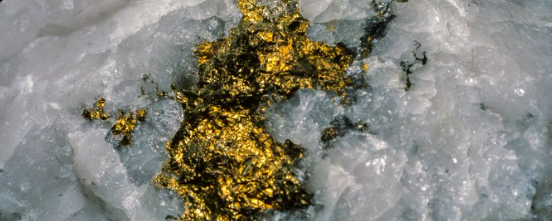Some gold deposits are believed to form directly from magmatic processes. In this theory, gold is dissolved in molten rock (magma) deep within the Earth’s mantle. As the magma ascends towards the surface, it cools and crystallizes, and gold can become concentrated in certain minerals or rock types. This is known as a magmatic segregation process, and the resulting deposits are often found in conjunction with other metals like copper and platinum.
Recent discoveries by Australian scientists could potentially transform our understanding of how gold nuggets form beneath the Earth’s surface. Researchers from Monash University, the CSIRO, and the Australian Nuclear Science and Technology Organisation have introduced a new perspective on the formation of gold in natural settings, challenging traditional theories.
What’s New? A radical theory suggests that earthquakes may spark gold nuggets into existence. Researchers propose that the intense pressure changes during seismic activity can cause gold to rapidly precipitate from fluids in faults, potentially forming nuggets almost… pic.twitter.com/nbecWUCJXT
— xKnowledge (@xSourced) September 2, 2024
Typically, it is known that seismic activities push water containing dissolved gases, metals, and minerals from deep within the Earth’s crust to the surface. Quartz, a crystalized form of silicon dioxide, is often found in conjunction with gold, as both precipitate from these solutions under similar environmental conditions, such as high pressures and temperatures.
Another theory involves metamorphic processes, where existing rocks are transformed by high pressures and temperatures, typically deep within the Earth’s crust. This transformation can release gold from the host rock into surrounding fluid systems, which then transport the gold into cracks and faults where it precipitates and forms deposits. This type of formation is often associated with mountain-building events where large-scale tectonic forces are at play.
However, the conventional explanation does not fully account for the formation of substantial gold nuggets, especially given the low concentration of gold in these geological fluids. Gold’s solubility in water is notably poor, usually not exceeding one part per million, yet gold deposits are found at concentrations vastly higher than in the originating solutions.
How do you make a giant gold nugget? Take a vein of quartz, add a few thousand earthquakes. Some of the most impressive gold nuggets ever found have been in quartz veins where gold-bearing fluids flow through faults in earthquake-prone rock. https://t.co/eMqpdmKliZ via… pic.twitter.com/9rORdeqPqp
— Vazquez, Ø 🍯 (@VGO3696) September 3, 2024
Chris Voisey, a geologist at Monash University, and his team are exploring whether the relationship between quartz and gold might be more interconnected than previously thought. Quartz has the unique property of generating an electrical charge under pressure, known as the piezoelectric effect. The researchers speculate that during earthquakes, the electrical charges produced by stressed quartz could catalyze electrochemical reactions that concentrate gold from the surrounding solution into the quartz seams.
One of the most widely accepted theories is that gold deposits form through hydrothermal processes. In this scenario, hot, mineral-rich fluids circulate through cracks in the Earth’s crust. As these fluids cool, they deposit minerals, including gold, in veins and fissures. This process can occur deep underground or nearer the Earth’s surface in volcanic regions. Hydrothermal gold deposits are often associated with quartz veins, which act as conduits for the mineral-rich fluids.
To investigate this hypothesis, the team conducted experiments by placing quartz tiles in gold-rich solutions and subjecting them to vibrations mimicking minor earthquakes. These vibrations generated small electrical currents within the quartz. The experiments showed that micrometer-sized gold grains formed on the quartz tiles that were subjected to these vibrations, while control tiles showed no gold formation.
Further tests on quartz already containing minute gold particles demonstrated that these “seeds” of gold could grow in the presence of stress-induced electrical charges, suggesting that these existing gold particles might act as catalysts for drawing more gold from the solution.
Earthquakes may be responsible for the formation of large gold nuggets in quartz rock due to the generation of an electric field. A nearly 100-kilogram gold nugget found in Australia in 1869 supports this theory. pic.twitter.com/gFaCNlXv8u
— Science In 60 Mins (@ScienceIn60Mins) September 2, 2024
This study implies that piezoelectric effects within quartz during seismic activities could play a critical role in the formation and concentration of gold deposits. It also provides a novel explanation for why gold veins often appear integrated within quartz seams, without visible geochemical changes. On a geological timescale, this mechanism could explain the relatively rapid accumulation of gold in certain areas, offering a fresh perspective on an age-old geological puzzle.
Major Points:
- Australian scientists have challenged existing theories on gold formation, suggesting a new model involving the interaction of quartz and seismic activity.
- Traditional understanding posits that gold and quartz precipitate together from high-pressure and temperature solutions brought to the surface during seismic events.
- The new research proposes that the piezoelectric properties of quartz, which generate electrical charges when stressed, could catalyze the concentration of gold from surrounding solutions.
- Experiments demonstrated that vibrating quartz tiles in gold solutions led to the formation of gold grains, supporting the theory that electrical charges aid in gold deposition.
- This innovative approach could explain the frequent co-location of gold and quartz veins and the rapid accumulation of gold in geological terms, offering insights into previously unexplained phenomena in gold mining.
Conner T – Reprinted with permission of Whatfinger News



